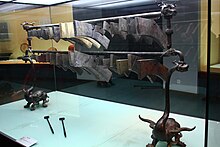| Bianqing | |||||||
|---|---|---|---|---|---|---|---|
 Bianqing from the Tomb of Marquis Yi of Zeng | |||||||
| Traditional Chinese | 編磬 | ||||||
| Simplified Chinese | 编磬 | ||||||
| |||||||
| Bianqing | |
| Hangul | 편경 |
|---|---|
| Hanja | 編磬 |
| Revised Romanization | pyeongyeong |
| McCune–Reischauer | p'yŏn'gyŏng |
The bianqing (IPA: [biːɛnʧɪŋ] Chinese: 编磬; pinyin: biānqìng [bi̯ɛn˥ t͡ɕʰiŋ˥˩]) is a traditional Chinese percussion instrument consisting of a set of L-shaped flat stone chimes known as qing, played melodically. The chimes were hung in a wooden frame and struck with a mallet. Along with the bronze bells called bianzhong, they were an important instrument in China's ritual and court music going back to ancient times.
The instrument was imported to Vietnam (where it is called biên khánh),[1] and Korea (where it is called pyeongyeong). In the 11th year of King Yejong of Goryeo (1116), it was imported from the Song Dynasty.[2] It is still used in Korean court and ritual music.
- ^ Đại Dương (2010-12-09). "Sắp phục chế thành công 2 bộ nhạc cụ độc đáo đã thất truyền". Retrieved 2016-10-15.
- ^ "편경(編磬) - 한국민족문화대백과사전". Encyclopedia of Korean Culture. Retrieved 2021-05-26.